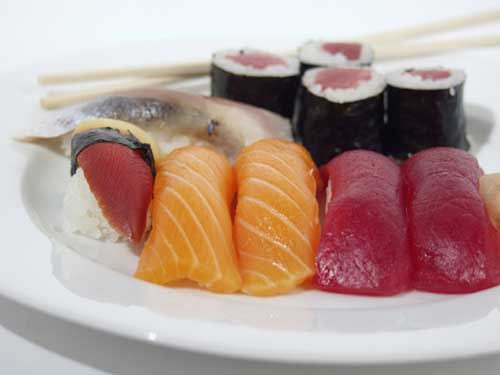Sushi and sashimi have become suburban chic in recent years. A few years ago, dropping terms such as ” nigiri” and ” hamachi” would have gotten you some seriously baffled looks. But now it seems that every pimply teenager has a lexicon of sushi terminology. People suddenly, and unfortunately, started saying things like “Is that a maki roll in your pocket or are you happy sashimi?” Glitzy sushi joints soon replaced sandwich shops in the neighborhood strip mall. Even though sushi places have become commonplace in America, there are still nuances the average Joe (Yes, plumbers and wannabe war correspondents like sushi too) may not know about the business of Japanese raw fish.
 |
1) Sushi Does Not Mean Raw Fish
There’s a common misconception that the word sushi means raw fish in Japanese, when it actually relates to the rice vinegar-infused sticky rice (sushi rice) that’s used to make maki rolls, nigiri and other rice-accompanied sushi items. Yet ” Hey, honey, let’s go have some rice with vinegar” doesn’t have the same appeal as the prospect of eating thin slices of raw fish over tiny pads of seasoned rice. Technically, the vinegary rice is called shari, which becomes sushi when paired with fish or vegetables.
2) You’re Probably Not Eating Fresh Fish
People assume that the fish is fresh when they go to a sushi place, but in reality, much of the fish comes into the restaurant in a frozen state. Some sushi chefs believe that blast-frozen fish tastes fresher than the ” fresh” stuff because it doesn’t sit around for hours aboard the ship, waiting to be processed. Plus, this method kills those nasty parasites. Of course, sushi chefs aren’t eager to tell you that your dinner was previously frozen. Before you get riled about this practice, consider this reality: eating thinly sliced dead parasites is much better than eating thinly sliced wiggly worms.
3) Real Wasabi is Hard to Come By
The wasabi that most American sushi joints serve is not, by Japanese standards, the real thing. Those pasty little dabs that come ornately presented with pickled ginger are usually made from horseradish powder mixed with green food coloring and dry mustard. Real wasabi, bright green Japanese horseradish root that gets mashed into paste, is incredibly spicy, and expensive, to boot. Also, wasabi shouldn’t be lathered on the fish like icing on a cake; it, along with pickled ginger, is supposed to be eaten sparingly after taking a bite of fish.
 |
| Fresh Wasabi root |
4) Not All Ginger is Created Equal
Pickled ginger is another contentious issue amongst sushi purists. The majority of American sushi joints use pre-packaged pickled ginger, but some attentive sushi chefs shave their own ginger and pickle it themselves. Most of the processed pickled ginger (pink or golden yellow) that restaurants use is packed with aspartame and potassium sorbate, and some processors even use MSG. Aspartame, the main ingredient in Equal, NutraSweet and Spoonful, is an artificial sweetener. Potassium sorbate gets used as a preservative. The pink ginger is dyed with red food coloring.
5) Beware of High Mercury Levels
High mercury levels are common in large fish species such as yellowfin tuna and blue marlin. But you generally aren’t going to see this information printed on menus. Some sushi restaurants voluntarily state that eating raw fish in massive quantities is not advisable for children and pregnant women. Broadway actor Jeremy Piven, who reportedly consumed a steady diet of sashimi and sushi, recently quit his role in “Speed- the-Plow,” in the middle of its run, because toxic mercury levels were found in his bloodstream. Playwright David Mamet later mused that Piven left the production to start a career as a thermometer.
We always want to be transparent and honest about our article content. From time to time, we may link to products and services that compensate us for the referral. This does not affect your cost, but it does help us fund future content for this site.
